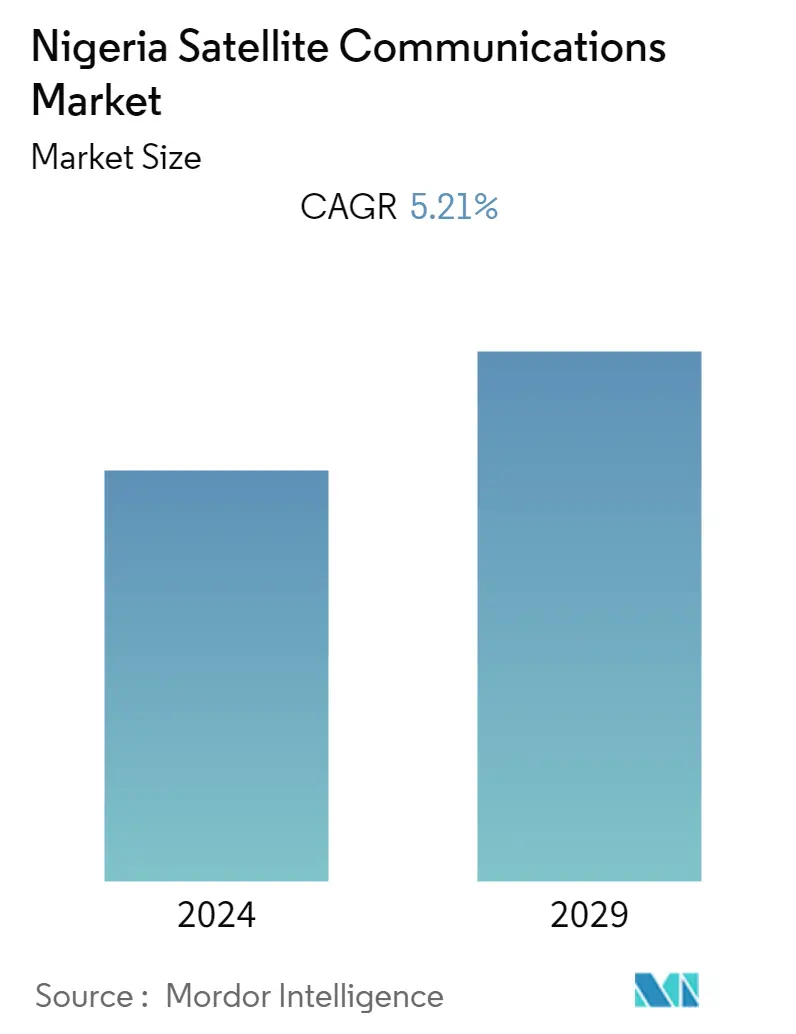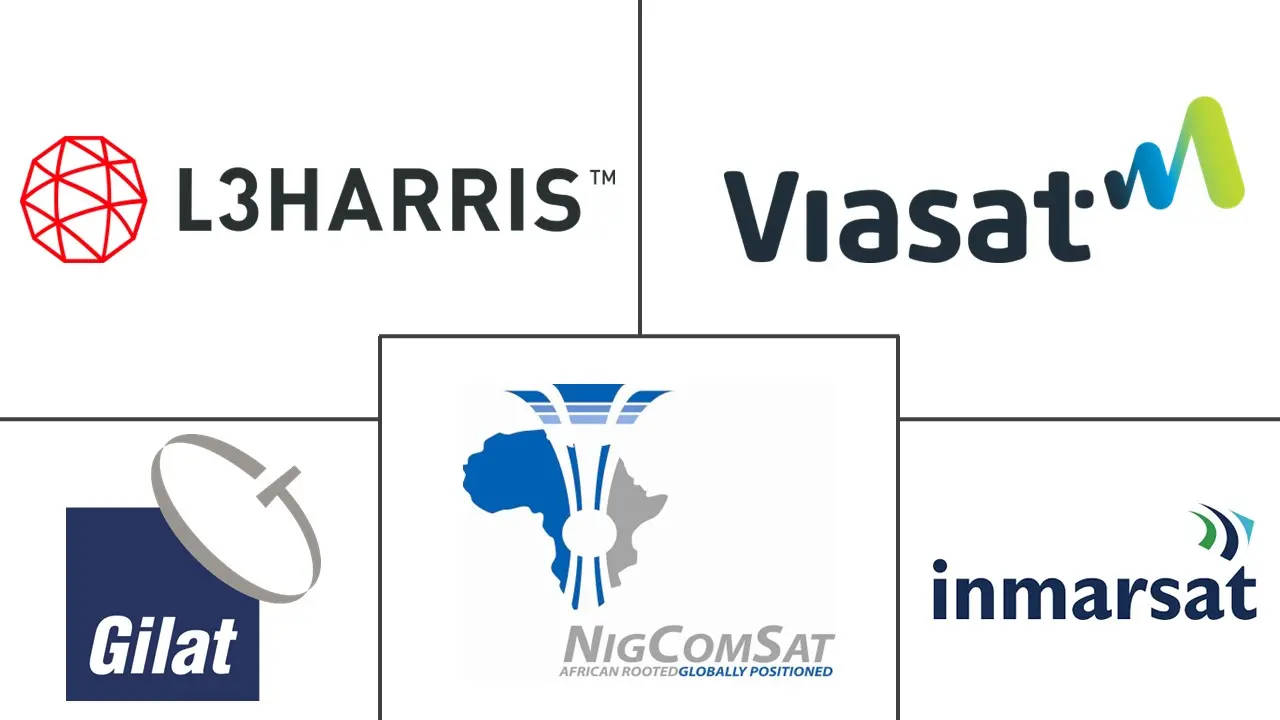Market Size of Nigeria Satellite Communications Industry

| Study Period | 2019 - 2029 |
| Base Year For Estimation | 2023 |
| Forecast Data Period | 2024 - 2029 |
| Historical Data Period | 2019 - 2022 |
| CAGR | 5.21 % |
| Market Concentration | Medium |
Major Players
*Disclaimer: Major Players sorted in no particular order |
Nigeria Satellite Communications Market Analysis
The Nigeria satellite communications market was valued at 220.0 million in last year and is expected to register a CAGR of 5.21% during the forecast period to reach around 300 million. In Nigeria, satellite communication is used for various applications across industries, such as media broadcasting, an extension of broadband coverage, 5G communications systems, integration and convergence of diverse wired and wireless technologies, earth observation, defense and security, and surveillance applications.
- Factors like the rising demand for mobile broadband, the growing use of smartphones and smart wearable devices, and the surging demand for mobile video adoption are expected to drive the growth of 5G over the forecast period, which is expected to aid the growth of the market studied. Furthermore, advancements in miniaturization, connected technologies, robust network environment, low-power computing, radio frequency identification, and M2M communication are anticipated to drive the satellite communication market.
- The satellite communications sector is a diverse, complex space and is heavily influenced by technological changes, regulations, and government and private investment decisions. The profit margins vary widely across this market among the end-user industries. The capital requirements, barriers to entry, and the influence of government and private stakeholders also vary across the market.
- The market is also driven by the government innitiatives in the Federal Government of Nigeria has launched DELSAT-1, an integrated satellite designed to improve the operational capabilities of Nigeria's military forces in the face of instability. This would help to realise the nation's sectoral policies, such as the National Defence Policy, National Counter-Terrorism Strategy, and National Policy on Public Safety and Security, which respond to recognised threats to Nigeria's national interests. Furthermore, the satellite project will help to create jobs and expand the nation's digital economy.
- With the increasing demand of satellite communication system in Nigeria, in April 2023, the chief of defence space administration, air vice marshall Ayo Jolasinmi, announced that Nigeria is going to launch Satellites II and III into space.
- The satellite communication industry has played an important role during the COVID-19 pandemic. The demand for satellite communication increased due to its vast applications in providing voice, data and broadcast communications solutions along with navigation, earth observation, remote sensing and other unique services vital for businesses, government customers and consumers in Nigeria.
Nigeria Satellite Communications Industry Segmentation
The Satellite Communications (SATCOM) market is defined based on the revenues generated from the types that are being used in various end-use industries such as Maritime, Defense & Government, Enterprises, and Media & Entertainment, among other end-users. The analysis is based on the market insights captured through secondary research and the primaries. The market also covers the major factors impacting the growth of the market in terms of drivers and restraints. The scope of the study has been segmented based on the type of satellite communication equipment and services ground equipment (a gateway, very small aperture terminal (VSAT) equipment, network operation center (NOC), and satellite newsgathering (SNG) equipment) and Services (mobile satellite services (MSS), fixed satellite services, and earth observation services) and end-use industries (Maritime, Defense & Government, Enterprises, Media & Entertainment, and other end-users). Common satellite communication services include voice calling and internet access for different applications. The study tracks the key market parameters, underlying growth influencers, and major vendors operating in the industry, which supports the market estimations and growth rates over the forecast period. The study also tracks the revenue accrued through the sale of grown equipment and communication services that are being used in various end-user industries across geography. In addition, the study provides the SATCOM market trends, along with key vendor profiles. The study further analyses the overall impact of COVID-19 on the ecosystem.
Nigeria Satellite Communications Market is Segmented By Type (Ground Equipment, Services), By Platform (Portable, Land, Maritime, Airborn3), By End-user Vertical (Maritime, Defense and Government, Enterprises, Media and Entertainment, Other End-user Verticals), and Country.
The market sizes and forecasts are provided in terms of value (USD million) for all the above segments.
Nigeria Satellite Communications Market Size Summary
The Nigeria satellite communications market is experiencing significant growth, driven by its diverse applications across various sectors such as media broadcasting, broadband expansion, 5G communications, and defense. The market is influenced by technological advancements, government initiatives, and the increasing adoption of IoT and connected devices. The Nigerian government's efforts, such as the launch of DELSAT-1 and the upcoming Satellites II and III, aim to enhance national security and expand the digital economy. The sector's complexity is underscored by varying profit margins, capital requirements, and the impact of both government and private investments. The COVID-19 pandemic further highlighted the importance of satellite communications in providing essential services like voice, data, and navigation.
In the media and entertainment industry, satellite communication has transformed content distribution, enabling efficient broadcasting and real-time news coverage, thereby enhancing transparency and public engagement. The adoption of Direct-to-Home (DTH) services has increased access to a wide range of channels, democratizing information and entertainment. The market is moderately consolidated, with key players like Inmarsat, Iridium Communications, and NigComSat leading the way through strategic partnerships and innovations. Recent collaborations, such as those involving NigComSat and SpaceX, underscore the ongoing efforts to expand satellite coverage and services in Nigeria, positioning the country as a significant player in the African satellite communications landscape.
Nigeria Satellite Communications Market Size - Table of Contents
-
1. MARKET INSIGHTS
-
1.1 Market Overview
-
1.2 Industry Attractiveness - Porter's Five Forces Analysis
-
1.2.1 Bargaining Power of Buyers
-
1.2.2 Bargaining Power of Suppliers
-
1.2.3 Threat of New Entrants
-
1.2.4 Threat of Substitutes
-
1.2.5 Intensity of Competitive Rivalry
-
-
1.3 Industry Value Chain Analysis
-
1.4 Assessment of the Impact of COVID-19 on the Market
-
-
2. MARKET SEGMENTATION
-
2.1 By Type
-
2.1.1 Ground Equipment
-
2.1.2 Services
-
-
2.2 By Platform
-
2.2.1 Portable
-
2.2.2 Land
-
2.2.3 Maritime
-
2.2.4 Airborn3
-
-
2.3 By End-user Vertical
-
2.3.1 Maritime
-
2.3.2 Defense and Government
-
2.3.3 Enterprises
-
2.3.4 Media and Entertainment
-
2.3.5 Other End-user Verticals
-
-
Nigeria Satellite Communications Market Size FAQs
What is the current Nigeria Satellite Communications Market size?
The Nigeria Satellite Communications Market is projected to register a CAGR of 5.21% during the forecast period (2024-2029)
Who are the key players in Nigeria Satellite Communications Market?
Inmarsat global limited , EUTELSAT COMMUNICATIONS SA, Türksat 5B satellite, Gilat Satellite Networks and ViaSat Inc. are the major companies operating in the Nigeria Satellite Communications Market.

